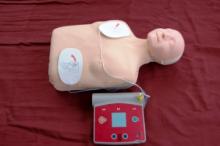
Sudden cardiac arrest (SCA) is an electrical malfunction of the heart, disrupting the heart muscle's normal rhythm, causing the heart muscle to twitch spasmodically. The heart then loses its ability to effectively pump blood. This activity is called ventricular fibrillation (VF).
Because the heart is not pumping blood, a person in VF usually has no detectable pulse. They suddenly collapse, become unresponsive, and stop breathing or breathe abnormally (gasping, labored breathing). Brief seizure-like activity is common in athletes with SCA. If untreated, this abrupt loss of heart function results in sudden cardiac death within minutes of onset.
SCA is the leading cause of sudden death in youth athletes, usually from an undetected heart condition (such as hypertrophic cardiomyopathy) or from an ill-timed blow to the chest (a condition called commotio cordis). In order to minimize death from SCA, not just of athletes but of game officials, coaches, and spectators, best youth sports safety practices require the following:
Pre-participation screening. Athletes should undergo cardiovascular screening before participation in competitive athletics. Screening should, at minimum, include the taking of a comprehensive personal history, family history, and physical examination. Athletes who experience cardiovascular symptoms during sports should be evaluated by a physician and require medical clearance before returning to sport participation. Patients with an identified cardiac disorder, unexplained symptoms, or previous sudden death events should be cleared by a cardiologist before returning to sport participation is considered. While electrocardiogram screening (ECG) is common in other countries, it has not the standard of care in the United States.
Annual AED training: Coaches, athletic trainers, and volunteers should be educated annually about the location, function and use of AEDs.
Proper management of SCA victims (Cardiac Chain of Survival) The Chain of Survival is a five-step process for providing treatment to SCA victims of sudden cardiac arrest
1. Prompt recognition of SCA. Determine that the victim has experienced a cardiac arrest, based on unresponsiveness and lack of normal breathing.
2. Immediate activation of the emergency response system. An immediate call to 911 is crucial; the sooner 911 or your local emergency number is called the sooner early advanced life support arrives. A delay of just a few minutes could prove fatal.
3. Early CPR. Once an SCA victim collapses and a bystander calls 911, the next step in the chain is to immediately begin chest compressions (Cardiopulmonary Resuscitation or CPR). The American Heart Association now recommends that all rescuers, regardless of training, or skill level, victim characteristics, or available resources, should provide chest compressions to all cardiac arrest victims, with rescuers who are able adding ventilations (mouth-to-mouth) to chest compressions. Rescuers should start CPR immediately. The directive to "look, listen, and feel for breathing" is no longer recommended. The focus should be on delivering high-quality CPR:
- providing chest compressions of adequate rate (at least 100-120/minute)
- providing chest compressions of adequate depth
- adults: a compression depth of at least 2 inches
- infants and children: a depth of at least 1 1/2 inches in infants and about 2 inches in children
- allowing complete chest recoil after each compression
- minimizing interruptions in compression
- avoiding excessive ventilation
- CPR and AED used within 8 Minutes: When CPR and defibrillation are provided within eight minutes of an episode, a person's chance of survival increases to 20%.
- CPR and AED Within 4 Minutes/EMS Within 8 Minutes: When these steps are provided within four minutes and a paramedic arrives within eight minutes, the likelihood of survival increases to over 40%.
- Defibrillation Within 5 To 7 Minutes: 49% Survival Rate. According to the AHA, the survival rate from SCA is as high as 49% where defibrillation occurs within 5 to 7 minutes of collapse. Survival rates between 70 and 89% were recently reported at U.S. high schools with AEDs.



